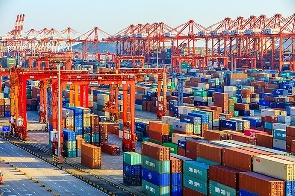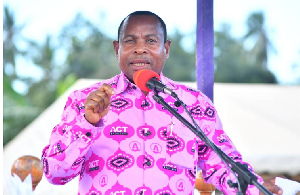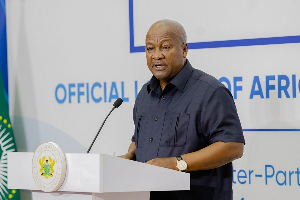The Bank of Ghana has said despite the mixed performance in the prices of Ghana’s major commodities, the trade balance improved in the first two months of 2023 mainly on the back of higher export volumes.
“In the first two months, total exports expanded by 11.2 per cent year-on-year to US$2.8 billion, driven mainly by higher gold, cocoa, and other export receipts”, Governor Ernest Addison said in a statement at the central bank’s recent Monetary Policy Committee meeting.
The value of gold exports amounted to US$1.1 billion, representing an increase of 35.8 per cent, driven mainly by a 38.5 per cent increase in export volumes to 619,373 ounces, Dr Addison said.
Cocoa beans and product exports increased by 15.5 per cent and 3.3 per cent to US$387.6 million and US$159.3 million, respectively, mainly on the back of higher production volumes, the BoG noted.
The bank said earnings from ‘other’ exports, including non-traditional exports, were estimated at US$538.2 million, representing a 10.8 per cent year-on-year growth.
In contrast, exports of crude oil declined by 18.3 per cent to US$562.6 million, largely due to lower export volumes.
Read the MPC’s full statement below:
Good morning, ladies and gentlemen of the media and welcome to the press briefing after the 111th Monetary Policy Committee (MPC) meetings which took place last week.
The Committee deliberated on recent macroeconomic developments and assessed the current state of the economy and risks to the inflation and growth outlook.
A summary of the assessment and key considerations that informed the Committee’s decision on the stance of monetary policy is provided below:
1. Global growth is projected to decline in 2023 to 2.9 percent, down from the 3.4 percent in 2022 (according to recent IMF projections released in January 2023). The projected slowdown comes on the back of persistent elevated inflation levels, tightened financial conditions, and uncertainty stemming from the lingering effects of the Russia-Ukraine war. The onset of the recent turmoil in the banking sector in the U.S. and Europe is likely to further cloud the outlook. The above notwithstanding, latest Purchasing Managers’ Indices (PMI) pointed to some rebound in economic activity in February 2023, reflecting the moderation in price pressures, improved supply chains, and the re-opening of China’s economy. But it is unclear yet how the recent banking sector crises in the U.S. and Europe would impact this initial rebound.
2. Headline inflation in Advanced Economies appears to have peaked, and currently on a steady decline across advanced and emerging market economies, driven by lower energy and food prices stemming from weakened global demand and easing supply chain constraints. However, underlying inflationary pressures persist mainly from the pass-through effects of high input costs, rising wages especially in advanced economies, and currency depreciation against the U.S. dollar. In the outlook, global headline inflation is expected to ease to 6.6 percent by December 2023, from 8.8 percent in December 2022, reflecting declining fuel and non-fuel commodity prices and the effects of central bank policy actions.
3. Global financial conditions eased somewhat in early 2023 as slower growth and moderating inflation in advanced economies led markets to price in further reduction in the pace of future policy rate hikes. More recently, the U.S. Federal Bank of Ghana Monetary Policy Committee Press Release March 27, 2023 2 Reserve, European Central Bank, and the Bank of England have all increased their respective policy rates, albeit at a slower pace, but with commitment to maintain a tight monetary policy stance until inflation is contained. Meanwhile, concerns that inflation may stay elevated for longer than previously anticipated kept long-term bond yields high, while fears about global growth prospects and the hawkish posture of central banks in advanced economies amid the ongoing turbulence in the banking system, have triggered volatility in the equities market.
4. On the Domestic Scene, recent price developments indicate that the inflation surge in the economy, witnessed since December 2021, has peaked. The latest two readings since the January MPC meeting indicated two consecutive drops in headline inflation from the peak of 54.1 percent in December 2022 to 53.6 percent in January 2023, and to 52.8 percent in February. The latest decline in inflation was attributed to lower food inflation, while non-food inflation remained broadly stable. Food inflation declined to 59.1 percent in February 2023 from 61.0 percent a month earlier, while non-food inflation remained flat at 47.9 percent.
5. Underlying inflationary pressures also eased in the first two months of the year. Excluding energy and utility prices, the Bank’s core inflation measure, declined from 53.2 percent in December 2022 to 52.8 percent in January and to 52.0 percent in February 2023. Also, the weighted inflation expectations of banks, consumers, and businesses, declined.
6. In the real sector, the Bank’s high frequency indicators pointed to further moderation in economic activity in line with the challenging macroeconomic environment. The January 2023 update of the Bank’s Composite Index of Economic Activity (CIEA) indicated a contraction in economic activity by 7.6 percent, compared to a growth rate of 4.2 percent in the same period of 2022. The main indicators that weighed down the Index during the period were port activity, cement sales, imports, and credit to the private sector.
7. While real sector activity showed continued decline, both business and consumer sentiments continued to show further improvement in February 2023. Consumer confidence improved on account of easing inflationary pressures which led to some optimism about future economic conditions. Also, business sentiments improved as companies met short-term targets amid positive company and industry prospects. The survey findings were consistent with observed trends in Ghana’s PMI for February 2023, which rose above the benchmark level of 50 for the first time since January 2022.
8. Development in the monetary aggregates in February 2023 showed strong growth in broad money supply (M2+), an indication of increased liquidity in the banking system, driven mainly by expansion in the Net Domestic Assets. M2+ recorded an annual growth of 44.9 percent in February 2023, compared with 17.7 percent in February 2022, reflected in currency outside banks and deposit liabilities of the 3 banking sector. Reserve money similarly went up by 54.3 percent compared with 21.9 percent, over the same comparative period.
9. Annual nominal growth in private sector credit was up by 29.5 percent in February 2023, compared with 17.1 percent in the corresponding period of 2022. However, in real terms, private sector credit contracted by 15.3 percent compared with 1.2 percent contraction, over the same period a year before, due to the high level of inflation.
10. Developments in the banking sector broadly reflected the challenging operating environment in 2022 on account of macroeconomic conditions, and the recent implementation of the Domestic Debt Exchange Programme (DDEP) which all 23 universal banks participated in. Our preliminary assessment of the impact of the DDEP on the banking sector, based on December 2022 data, indicates significant losses on account of impairment of banks’ holdings in GoG bonds. The impact of the DDEP as currently assessed is moderated by the timely introduction of regulatory reliefs by the Bank of Ghana to support the banking sector, similar to the reliefs provided to banks at the onset of the Covid-19 pandemic. As a result, the industry is still fairly resilient. Our preliminary assessment will be updated once banks’ external auditors complete their audits of banks’ 2022 financial performance making the necessary adjustments to fully reflect the DDEP impact. Banks are expected to publish their 2022 audited financial statements by end April 2023 following a one-month dispensation granted by the Bank of Ghana on the account of the DDEP.
11. Total assets of the industry stood at GH¢209.4 billion in December 2022, representing a growth of 16.4 percent, reflecting sustained growth in deposits and exchange rate variations on banks’ balance sheets. Total investments declined significantly to GH¢64.8 billion in December 2022 from GH¢83.1 billion in December 2021, indicating a contraction of 22.1 percent, compared with the 29.0 percent growth in the same period a year before. Total credit, on the other hand, increased by 28.5 percent to GH¢69.1 billion in December 2022 from GH¢53.8 billion in December 2021. Of the total liabilities of the banking system, total deposits stood at GH¢157.9 billion, representing an increase of 30.4 percent year-on-year, compared with 16.6 percent recorded during the same period in 2021.
12. Key financial soundness indicators remained broadly sound, supported largely by the regulatory reliefs provided by the Bank. Among others, the minimum Capital Adequacy Ratio (CAR) required to be maintained by banks was reduced from 13 percent to 10 percent as of 31st December 2022, and losses from the DDEP are to be reflected in the computation of CAR over a period of up to three (3) years. Accordingly, the industry’s average CAR adjusted for the regulatory reliefs was 15.7 percent in December 2022, compared with the CAR of 16.6 percent as of December 2022 without the DDEP. The adjusted CAR reflected valuation losses on GoG bonds, elevated credit risk, and revaluation losses on foreign currency-denominated loans. Asset quality marginally improved, with the industry’s Non- 4 Performing Loans (NPL) ratio at 15.1 percent in December 2022, almost unchanged from 15.2 percent in December 2021, reflecting the higher growth in credit, which outpaced the growth in the NPL stock.
13. Provisional data on budget execution for January – December 2022 indicated a higher overall broad fiscal deficit (cash basis) of GH¢49.7 billion (8.1 percent of GDP), against the revised mid-year 2022 target of GH¢38.9 billion (6.3 percent of GDP). The primary balance (on cash basis) recorded a deficit of GH¢4.0 billion (0.6 percent of GDP), against a primary surplus target of GH¢2.5 billion (0.4 percent of GDP). Total revenue and grants amounted to GH¢96.7 billion (15.7 percent of GDP), marginally short of the revised target of GH¢96.8 billion (15.73 percent of GDP). Total expenditure was GH¢146.3 billion (23.8 percent of GDP) above the revised target of GH¢135.7 billion (22.0 percent of GDP). These developments resulted in a deficit of GH¢49.7 billion, of which GH¢48.2 billion was financed from domestic sources.
14. Prices of Ghana’s major export commodities traded mixed in February 2023 relative to the same period in 2022. Brent crude oil prices, which had been on a downward trend during the later part of 2022, increased in the first two months of 2023 as China gradually relaxed its COVID-19 restrictions. Brent crude oil dipped by 11.0 percent to US$83.9 per barrel in February 2023 from US$94.3 per barrel in February 2022. For the same period, cocoa beans traded at US$2,677.8 per tonne compared to US$2,681.1 per tonne. In contrast, gold prices recorded some marginal gains of 0.1 percent to settle at US$1,858.9 per fine ounce in February 2023, driven largely by weak US dollar and expectation of further interest rate hikes by the Federal Reserve Bank.
15. Despite the mixed performance in the prices of Ghana’s major commodities, the trade balance improved in the first two months of 2023 mainly on the back of higher export volumes. In the first two months, total exports expanded by 11.2 percent year-on-year to US$2.8 billion, driven mainly by higher gold, cocoa, and other export receipts. The value of gold exports amounted to US$1.1 billion, representing an increase of 35.8 percent, driven mainly by a 38.5 percent increase in export volumes to 619,373 ounces. Cocoa beans and product exports increased by 15.5 percent and 3.3 percent to US$387.6 million and US$159.3 million respectively, mainly on the back of higher production volumes. Earnings from ‘other’ exports, including non-traditional exports, were estimated at US$538.2 million, representing a 10.8 percent year-on-year growth. In contrast, exports of crude oil declined by 18.3 percent to US$562.6 million, largely due to lower export volumes.
16. The total import bill on the other hand, declined by 11.8 percent year-on-year to US$2.0 billion, driven by compression in non-oil imports. Non-oil imports dipped by 17.6 percent to US$1.4 billion, while oil and gas imports increased marginally by 4.8 percent to US$622.9 million. The combination of exports growth and lower imports resulted in a trade surplus of US$752.8 million for the first two months of 5 2023, higher than the trade surplus of US$205.8 million recorded for the same period in 2022.
17. For the year 2022, the overall balance of payments recorded a deficit of US$3.6 billion. The capital and financial account recorded a net outflow of US$2.1 billion (2.9 percent of GDP), mainly on account of lower FDI flows and significant portfolio reversals. These, together with the current account deficit of US$1.5 billion (2.1 percent of GDP), resulted in the deficit of the overall balance. As a result, Gross International Reserves for 2022 declined by US$3.5 billion to US$6.2 billion. Net International Reserves, which adjusts Gross reserves for the Heritage and Stabilization funds as well as other encumbered funds also declined by US$3.7 billion to settle at US$2.4 billion by December 2022. Gross International Reserves further declined to US$5.9 billion at the end of February 2023, providing cover for 2.8 months of imports of goods and services. However, Net International Reserves improved to US$2.6 billion, reflecting a slight decline in encumbered funds.
18. The local currency has been under pressure since October 2022, reflecting concerns about the DDEP, further sovereign rating downgrades, and seasonal demand pressures. However, the progress made on the DDEP and positive sentiments, thereafter, including the beginning of discussions with external debtors improved sentiments and helped reverse some of the losses. In the year to March 22, 2023, the Ghana cedi cumulatively depreciated by 22.1 percent, 23.5 percent, and 23.1 percent against the US dollar, the Pound, and Euro, respectively.
Summary and Outlook
19. To summarise, the Committee observed that, global growth is projected to moderate further, but with positive prospects of easing price pressures, improved supply chain constraints, and re-opening of China’s economy. However, risks to the growth outlook are still tilted to the downside, reflecting the lagged impact of policy rate hikes, potential slowdown effects from the recent banking sector turmoil in advanced economies, and further ramifications from the lingering geopolitical tensions.
20. Global inflation is easing as food and energy prices moderate due to weakened global demand, improved supply of goods, and continued monetary policy tightening. Despite the emerging risks to global financial stability, central banks in major advanced economies have demonstrated strong commitment to containing underlying inflationary pressures with sustained policy rate hikes, albeit, at lower rates than earlier anticipated. Global financing conditions have eased slightly, reflecting changing market expectations regarding the pace of policy tightening.
21. The US dollar index initially firmed up amid rising demand for safe-haven currencies following the collapse of Silicon Valley Bank and Signature Bank, but so far, swift regulatory action and assurances to contain contagion risks, combined 6 with decisions to boost dollar liquidity somewhat eased market concerns about a wider banking and financial crisis.
22. The Committee was of the view that the ease in price pressures abroad would likely impact positively on Ghana’s domestic inflation profile. On the other hand, the Committee noted that, the domestic economy still faces relatively tight global financing conditions, emerging risks in the global financial system, and heightened uncertainty about the global economic outlook. The effects of these on the domestic economy could be amplified by inherent vulnerabilities, including structural excess liquidity following the DDEP, and the widening negative output gap.
23. The macro-prudential risk assessments conducted during the last MPC meeting indicated increased pressure on profitability and solvency of banks prior to the implementation of the DDEP. The preliminary data available at this MPC, show that the pre-pandemic capital buffers in the banking sector have been weakened somewhat by the recent macroeconomic challenges and the DDEP, although banks remain liquid. These require contingency measures by banks, supported by the regulatory reliefs to contain potential risks to financial stability. The Bank of Ghana will continue to monitor these developments going forward, and stands ready to act very swiftly to safeguard the stability of the financial sector.
24. On fiscal policy, the Committee noted that the budget statement for 2023 has set fiscal policy on a consolidation path which is consistent with key elements agreed with the IMF at the Staff Level in December 2022. The domestic debt exchange, new revenue measures, and structural fiscal reforms will provide significant reduction of debt service and help create fiscal space. The fiscal outlook is contingent on financing of the budget and will require the conclusion of the domestic debt exchange programme as well as securing the requisite financing assurances from bilateral donors. Indications are that these discussions are proceeding well. Based on the above, it is imperative that Parliament prioritizes the passage of the revenue bills currently before it. Under the Staff Level Agreement with the IMF, the Bank of Ghana and the Ministry of Finance have finalised a Memorandum of Understanding on zero financing to the budget, which will be signed shortly. The passage of the relevant revenue bills by Parliament will therefore conclude the required prior actions to advance Ghana’s programme to the IMF Executive Board. This will be critical in resetting the economy on the path of recovery, including putting it firmly on a disinflation path and sustained growth.
25. Headline inflation has declined marginally for two consecutive months, but continues to remain relatively high compared to the medium-term target of 8±2 percent. To place the economy firmly on the path of stability and reinforce the pace of disinflation, it is important that the monetary policy stance be tuned further to re-anchor inflation expectations towards the medium-term target.
Given these considerations, the MPC decided to increase the Monetary Policy Rate by 150 basis points to 29.5 percent.
Additional Measures
26. The Committee also decided to reset the Cash Reserve Ratio on domestic currency deposits for banks from 12 percent to 14 per cent, effective 13th April, 2023.
In addition, the Bank will step up liquidity management operations to address excess liquidity conditions in the market.
The Committee will continue to monitor developments in the banking sector and deploy other macro-prudential tools to ensure financial stability.
Informational Note
The next Monetary Policy Committee (MPC) meeting is scheduled for May 17 - 19, 2023.
The meeting will conclude on Monday, May 22, 2023, with the announcement of the policy decision.
Business News of Tuesday, 28 March 2023
Source: classfmonline.com



![New IGP, COP Christian Tetteh Yohonu [L] and immediate-past IGP, Dr. Akuffo Dampare New IGP, COP Christian Tetteh Yohonu [L] and immediate-past IGP, Dr. Akuffo Dampare](https://cdn.ghanaweb.com/imagelib/pics/140/14041582.295.jpg)









